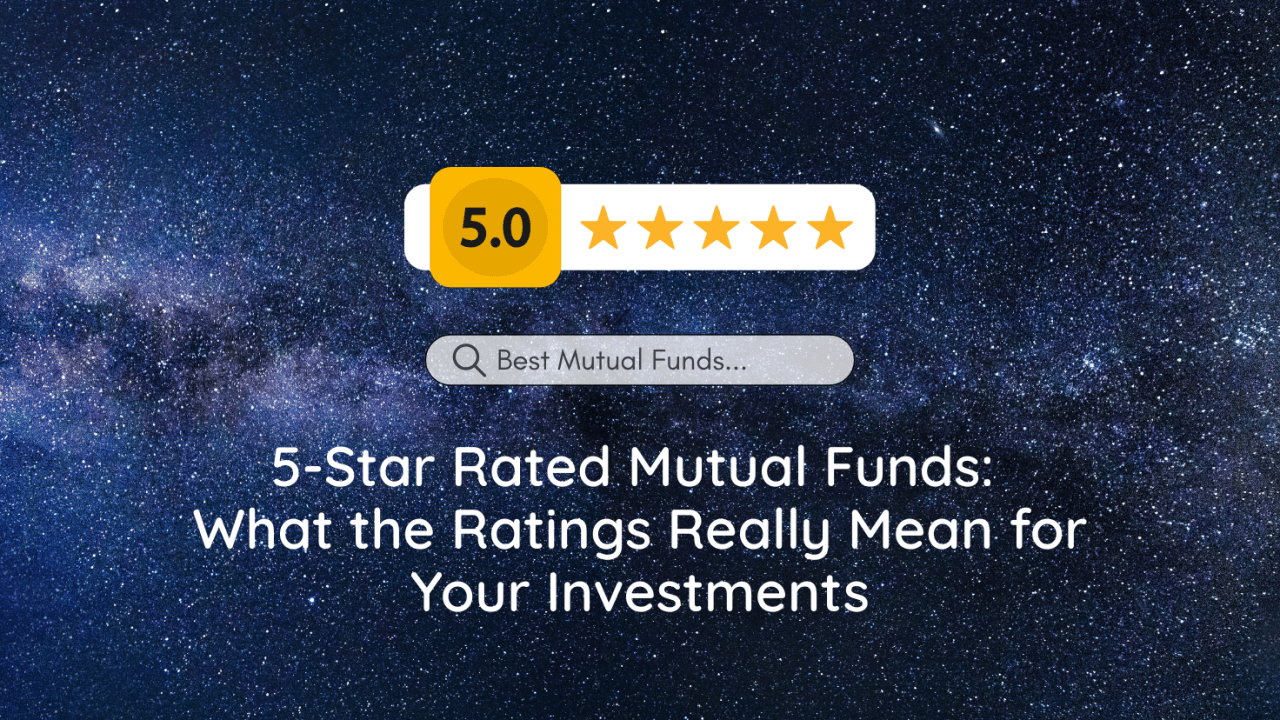If you’ve ever searched for mutual funds online, the chances are you would have seen those shiny 5-star ratings. They look reassuring—like a seal of approval. And it’s tempting to think, “Well, if it’s 5 stars, it must be the best”. You are not alone. Majority of investors – be it DIY or investing through a Mutual Fund Distributor or a Financial Advisor, they all often have a similar belief. Not only that, even when the invested funds underperform at times, we want to switch to another fund which has a 5-star rating at that time. All investors have an obsession that their investments should be always in the top-rated funds. The truth is, relying solely on star ratings to pick funds can be misleading. Let’s explore why ratings shouldn’t be the only factor for selecting a mutual fund.
Do 5-Star Rated Mutual Funds Ensure Best and Consistent Performance?
No, they don’t! A fund with a 5-star ratio can move to a 3-star or 1-star and vice versa. The fund ratings are more of an outcome of the fund’s history and not an assurance or a probability of similar and consistent future performance.
The best of the fund managers claim that they have a 50-55% success ratio for investment picks they make. The returns are primarily an outcome of the market. As fund managers, they work diligently to create a portfolio that they feel will work well and tweak it from time to time as and when necessary. However, there are various factors that the fund managers have no control over – political, geopolitical. oil price, climate (that can impact demand and supply) and many more factors. And these factors may derail even a well-thought portfolio and cause underperformance for a certain period.
From a rating agency’s viewpoint, despite covering multiple parameters like PE Ratio, PB Ratio, Standard Deviation, Concentration and so on, the central point usually boils down to the fund’s performance. Ratings are generally the mirror of the funds’ history and a relative comparison of where they stand today among the peers. Therefore, the ratings do not form a base for an investor to pick a fund expecting similar future performance. Also, every research agency follows different methodology for rating funds. Hence, it is not that straightforward as it might look.
How are Mutual Fund Ratings Determined?
Generally, a good rating indicates that the fund has a good performance track record. A fund’s performance is driven by multiple factors. Factors like the theme the fund runs, investment style they follow, the market scenario, periodic sectoral rotation etc. influence the performance of the funds. Ratings are derived typically based on multiple parameters like historical performance, risk-adjusted returns, market cycles they have been through, performance consistency compared to the peers and other factors including fund manager’s track record. However, there are no universal guidelines or regulations on how the fund ratings should be derived.
This highlights the fact that star rating is not an absolute indicator of a fund’s consistency or an assurance of future performance. For example, a fund may earn a good rating because it performed exceptionally well in the recent past (because the fund management team’s strategy and decisions paid off well). Every fund goes through multiple cycles of ups and downs which can be either due to the market factors (beyond anyone’s control) or due to the investment style (growth, value etc.) that the fund follows. Sometimes a cautious approach by the fund management team may result in missing the bus and sometimes the fund might have been too early for the theme to play out.
Sometimes funds with shorter track records may achieve higher ratings based on recent performance or they can even go unrated. But does that make those funds a bad choice? It just means there’s less historical data to filter them through the rating process to arrive at any conclusion.
What Should Investors Focus On?
While ratings can be a helpful starting point, it shouldn’t be the sole criterion for choosing mutual funds. As investors, you should follow an approach which focuses on what is important—one that starts with you and your goals.
- Identify Short, Medium, and Long-Term Goals: First, clearly define your financial goals based on their time horizon (which goals needs to be achieved when). You can segregate them into three different time buckets:
- Short-term goals (3 months – 3 years) could include building an emergency fund or saving for a vacation or any such goal that you need to achieve within next 3 years.
- Medium-term goals (3 – 5 years) might involve buying a car or funding higher education, buying a home, and so on.
- Long-term goals (5 – 6+ years) typically include retirement planning, children’s future needs, purchasing a home or achieving early Financial Independence.
Note: These goals may vary for every individual or family. You can take an expert’s help to identify them and plan for it.
- Short-term goals (3 months – 3 years) could include building an emergency fund or saving for a vacation or any such goal that you need to achieve within next 3 years.
- Determine Time Required to Reach Each Goal: Once you have the clarity on your goals, assess how much time you need to achieve each goal. This will help you understand whether the goal fall under short-term, medium-term or long-term category. For example – if you are 30 years old and need to retire by 50, you know that you have 20 years to accumulate the retirement corpus, and this qualifies as your long-term goal.
- Assess Risk Tolerance: Understand the suitable risk tolerance required for achieving these goals. Low-risk – low-return products are generally suitable for your short-term goals (up to 3 years) as capital preservation is the priority. For your medium-term goals (3 to 5 years), you can consider moderate to moderately high-risk products for a better risk and tax adjusted returns. And for your long-term goals (above 5-6 years), you can consider investing in high-risk – high-returns product to ensure your money grows beyond inflation in the long run.
- Select Suitable Mutual Fund Categories: Based on your goals and the suitable risk tolerance for achieving each goal, select the appropriate mutual fund category. For short-term goals, consider funds like liquid funds, arbitrage funds or ultra short-term funds. For medium-term goals, certain hybrid funds like the Dynamic Asset Allocation Funds are the most suitable funds. For long-term goals, a combination of diversified equity funds, index funds and gold funds can be considered.
- Select the Right Funds: After identifying the suitable fund categories, select a combination of funds that can help you achieve the goals efficiently. Ex: combination of equity fund should have a right mix of large, mid and small cap investments at the portfolio level. Click here to read our blog on how to build a mutual fund portfolio.
Use Ratings as a Tool, Not a Rule
Star ratings can act as one of the helpful tools for narrowing down your options, but they shouldn’t dictate your final choice. Ratings are often based on historical or immediate past performance. After shortlisting funds based on ratings, dig deeper to analyse their investment strategies, consistency across different market conditions, portfolio composition, risk levels etc. More importantly, you should focus on whether the fund’s objectives are aligning with your goals. Consulting a financial advisor can provide valuable insights tailored to help you achieve your goals and to ensure the choice of funds is not biased by data points that may not be so relevant for your financial goals.
Make Informed Investment Decisions
Investing in mutual funds is not about chasing the highest-rated schemes. It’s about aligning your investments with your goals and the suitable risk tolerance required to achieve them efficiently. Star ratings can provide a starting point, but informed decisions require thorough research and guidance. If you want your portfolio to include only 5-star rated funds, then you will end up with frequent churning of mutual fund schemes in your portfolio. You will invest in a fund when it has a 5-star rating and for some reason if the rating goes down in a year or two, you will end up exiting the fund. This will not only disrupt your journey of wealth creation but also end up incurring a higher tax liability year on year. More than that, you carry reinvestment risk which can be detrimental for your overall financial wellbeing.
Instead, your focus should be on setting clear financial goals, understanding the risk tolerance, and selecting the appropriate mutual fund categories that align with your goals. Increase your investments as and when your income goes up, give weightage to investment discipline & consistency, and consult an expert for your investment needs. By following this, you can build a diversified mutual fund portfolio that can ensure you achieve your goals with highest probability. Additionally, involving a financial advisor or a mutual fund distributor can help you navigate your emotions (and greed) and guide you to make decisions based on your life stage, and not just basis a rating. Remember, investing is a journey, not a race. Successful investing is not about quick wins but about staying committed to a strategy that will work for you in the long run.

Shreedhara is the Founder & Director of Ara Financial Services Pvt. Ltd. He has an experience of over 2 decades in Financial Service Industry with majority of it in guiding individuals and institutions on their investments requirements.










2 thoughts on “5-Star Rated Mutual Funds: What the Ratings Really Mean for Your Investments”
Avery realistic approch for mutual fund investment with awareness not merely blindly
Builds us confidence
Thanks a million dear sreedhara bhatji
Nicely advised article. In uncertain and risk prone market conditions due to various factors, this is the best one can do as suggested. Though ultimately it is luck and lottery success but what we have in our hand as investors to follow the guidelines as stipulated in the article.
Thanks